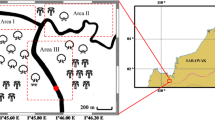Abstract
Holothuria leucospilota Brandt, the large black sea cucumber, is a non-selective deposit feeder, and is commonly found in the bottom of shallow waters in Hong Kong, where the sediments are often polluted with heavy metals. This study was designed to test the possibility of heavy metal accumulation by the sea cucumber at two sites in Hong Kong. Atomic absorption spectrophotometer was used to measure Cu and Zn concentrations in various tissue/organs of the animal as well as in the sediments. The result indicated that H. leucospilota accumulated zinc in the longitudinal muscle bands (97.27–98.07 ppm in dry weight) and in the respiratory tree (83.92–89.64 ppm in dry weight). Copper concentrations in these two organs were much lower than that of zinc. After the animals were kept in the aquarium without sediment for40 days, zinc concentration of the longitudinal muscle and respiratory tree decreased by 48% and 39%respectively whereas copper concentration remained unchanged. The concentrations of zinc and copper in the sediment at the two sites differed significantly but the metal level in the animals from the two sites were similar, suggesting that this sea cucumber was not an ideal bioindicator of heavy metal pollution in the sediment.
Similar content being viewed by others
References
Agemian, H., D. P. Sturtevant & K. D. Austen, 1980. Simultaneous acid extraction of six trace metals from fish tissue by hot-block digestion and determination by atomic-absorption spectrometry. Analyst 105: 125–130.
Bohn, A., 1979. Trace metals in fucoid algae and purple sea urchins near a high Arctic lead/zinc ore deposit. Mar. Pollut. Bull. 10: 325–327.
Brooks, R. R. & M. G. Rumsby, 1965. The biogeochemistry of trace element uptake by some New Zealand bivalves. Limnol. Oceanagr. 10: 521–527.
Brooks, R. R. & D. Rumsby, 1974. Heavy metals in some New Zealand commercial sea fishes. N.Z.J. mar. Res. 8: 155–166.
Bryan, G.W., 1968. Concentrations of zinc and copper in the tissues of decapod crustaceans. J. mar. biol. Ass. U.K. 48: 303–321.
Bryan, G. W., 1973. The occurrence and seasonal variation of trace metals in the scallops Pecten maximus (L.)and Chlamys opercularis (L.). J. mar. biol. Ass. U.K. 53: 145–146.
Bryan, G. W. & L. G. Hummerstone, 1973. Adaption of the polychaete Nereis diversicolorto estuarine sediments containing high concentrations of zinc and cadmium. J. mar. biol. Ass. U.K. 53: 839–857.
Bryan, G. W. & P. E. Gibbs, 1979. Zinc–a major inorganic component of nereid polychaete jaws. J. mar. biol. Ass. U.K. 59: 969–973.
Eisler, R., 1981. Trace metal concentrations in marine organisms. Pergamon Press, New York, 687 pp.
Julshamn, K. & O. Grahl-Nielsen. 1996. Distribution of trace elements from industrial discharges in the Hardangerfjord, Norway: a multivariate data analysis of saithe, flounder and blue mussel as sentinel organisms. Mar. Pollut. Bull. 32: 546–571.
Luoma, S. N., 1990. Processes affecting metal concentrations in estuarine and coastal marine sediments. In Furrness, R. W. & P. S. Rainbow (eds) Heavy Metals in the Marine Environment, CRC Press, Inc. Boca Raton: 51–66.
Martin, J. L. M., 1979. Schema of lethal action of copper on mussels. Bull. envir. Contamin. Toxicol. 21: 808–814.
Rainbow, P. S., 1990. Heavy metal levels in marine invertebrates. In Furrness, R. W. & P. S. Rainbow (eds) Heavy metals in the Marine Environment, CRC Press, Inc. Boca Raton: 67–81.
Saiz-alinas, J. I., J. M. Ruiz & G. Frances-Zubiliaga, 1996. Heavy metal levels in intertidal sediments and biota from the Bidasoa Estuary. Mar. Pollut. Bull. 32: 69–71.
Riley, J. P. & D. A. Segar, 1970. The distribution of the major and some minor elements in marine animals. I. Echinoderms and coelenterates. J. mar. biol. Ass. U.K. 50: 721–730.
Smiley, S., 1994. Holothurioidea. In Harrison, F. W. & F. S. Chia (eds), Microscopic anatomy of invertebrates, Vol. 14, Echinodermata, Wiley-Liss Publication, New York: 401–471.
Thompson, K. C. & K. Wagstaff, 1980. Simplified method for the determination of cadmium, chromium, copper, nicked, lead and zinc in sewage sludge using atomic-absorption spectrophotometry. Analyst 105: 883–896.
Thrower, S. J. & I. J. Eustace, 1973. Heavy metal accumulation in oysters grown in Tasmanian waters. Food Technol. Aust. Nov.: 546–553.
VandenSpiegel, D. & M. Jangoux, 1987. Cuvierian tubules of the holothuroid Holothuria forskali: a morphofunctional study. Mar. Biol. 96: 263–275.
Weeks, J. M. & P. S. Rainbow, 1993. The relative importance of food and sea water as sources of copper and zinc to talitrid amphipods (Crustacea; Amphipoda; Talitridae). J. appl. Ecol. 30: 722–735.
Warnau, M., G. Ledent, A. Temera, M. Jangoux & P. Dubois, 1995. Experimental cadmium contamination of the echinoid Paracentrotus lividus: influence of exposure mode and distribution of the metal in the organism. Mar. Ecol. Prog. Ser. 116: 117–124.
Ying, W. M., M. Ahsanullah & G. E. Batley, 1993. Accumulation and regulation of heavy metals by the intertidal snail Polinices sordidus. Mar. Biol. 116: 417–422.
Author information
Authors and Affiliations
Corresponding author
Rights and permissions
About this article
Cite this article
Xing, J., Chia, FS. Heavy metal accumulation in tissue/organs of a sea cucumber, Holothuria leucospilota. Hydrobiologia 352, 17–23 (1997). https://doi.org/10.1023/A:1003028601518
Issue Date:
DOI: https://doi.org/10.1023/A:1003028601518




